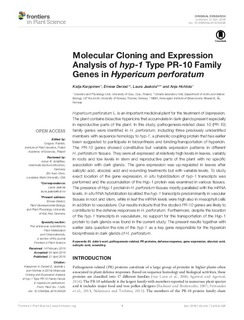| dc.contributor.author | Karppinen, Katja | |
| dc.contributor.author | Derzso, Emese | |
| dc.contributor.author | Jaakola, Laura | |
| dc.contributor.author | Hohtola, Anja | |
| dc.date.accessioned | 2018-05-30T06:31:09Z | |
| dc.date.available | 2018-05-30T06:31:09Z | |
| dc.date.created | 2016-07-19T16:04:31Z | |
| dc.date.issued | 2016 | |
| dc.identifier.citation | Karppinen, K., Derzsó, E., Jaakola, L., & Hohtola, A. (2016). Molecular cloning and expression analysis of hyp-1 type PR-10 family genes in Hypericum perforatum. Frontiers in plant science, 7, 526. | nb_NO |
| dc.identifier.issn | 1664-462X | |
| dc.identifier.uri | http://hdl.handle.net/11250/2499683 | |
| dc.description.abstract | Hypericum perforatum L. is an important medicinal plant for the treatment of depression. The plant contains bioactive hypericins that accumulate in dark glands present especially in reproductive parts of the plant. In this study, pathogenesis-related class 10 (PR-10) family genes were identified in H. perforatum, including three previously unidentified members with sequence homology to hyp-1, a phenolic coupling protein that has earlier been suggested to participate in biosynthesis and binding/transportation of hypericin. The PR-10 genes showed constitutive but variable expression patterns in different H. perforatum tissues. They were all expressed at relatively high levels in leaves, variably in roots and low levels in stem and reproductive parts of the plant with no specific association with dark glands. The gene expression was up-regulated in leaves after salicylic acid, abscisic acid and wounding treatments but with variable levels. To study exact location of the gene expression, in situ hybridization of hyp-1 transcripts was performed and the accumulation of the Hyp-1 protein was examined in various tissues. The presence of Hyp-1 protein in H. perforatum tissues mostly paralleled with the mRNA levels. In situ RNA hybridization localized the hyp-1 transcripts predominantly in vascular tissues in root and stem, while in leaf the mRNA levels were high also in mesophyll cells in addition to vasculature. Our results indicate that the studied PR-10 genes are likely to contribute to the defense responses in H. perforatum. Furthermore, despite the location of the hyp-1 transcripts in vasculature, no support for the transportation of the Hyp-1 protein to dark glands was found in the current study. The present results together with earlier data question the role of the hyp-1 as a key gene responsible for the hypericin biosynthesis in dark glands of H. perforatum. | nb_NO |
| dc.language.iso | eng | nb_NO |
| dc.rights | Navngivelse 4.0 Internasjonal | * |
| dc.rights.uri | http://creativecommons.org/licenses/by/4.0/deed.no | * |
| dc.title | Molecular Cloning and Expression Analysis of hyp-1 Type PR-10 Family Genes in Hypericum perforatum | nb_NO |
| dc.type | Journal article | nb_NO |
| dc.type | Peer reviewed | nb_NO |
| dc.description.version | publishedVersion | nb_NO |
| dc.rights.holder | © 2016 Karppinen, Derzsó, Jaakola and Hohtola. This is an open-access article distributed under the terms of the Creative Commons Attribution License (CC BY). The use, distribution or reproduction in other forums is permitted, provided the original author(s) or licensor are credited and that the original publication in this journal is cited, in accordance with accepted academic practice. No use, distribution or reproduction is permitted which does not comply with these terms. | nb_NO |
| dc.source.pagenumber | 12 | nb_NO |
| dc.source.volume | 7 | nb_NO |
| dc.source.journal | Frontiers in Plant Science | nb_NO |
| dc.identifier.doi | 10.3389/fpls.2016.00526 | |
| dc.identifier.cristin | 1368627 | |
| cristin.ispublished | true | |
| cristin.fulltext | original | |
| cristin.qualitycode | 1 | |

